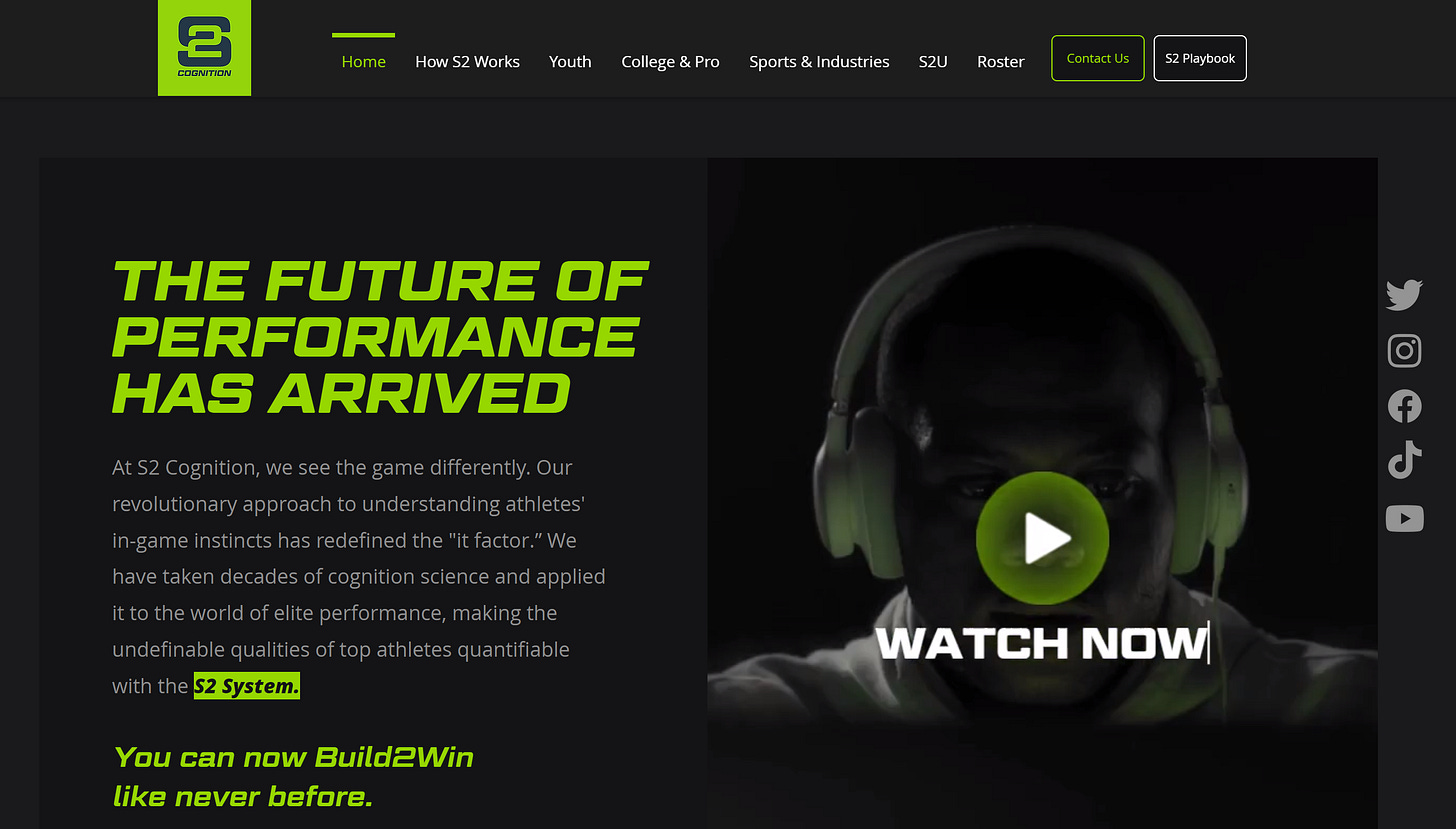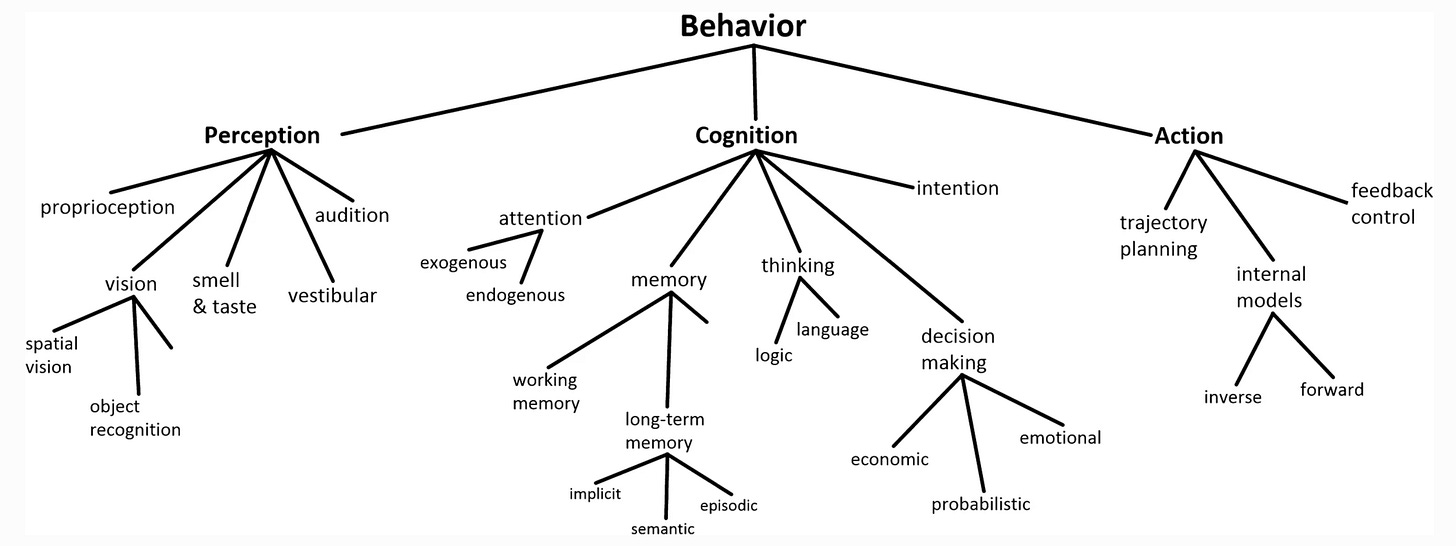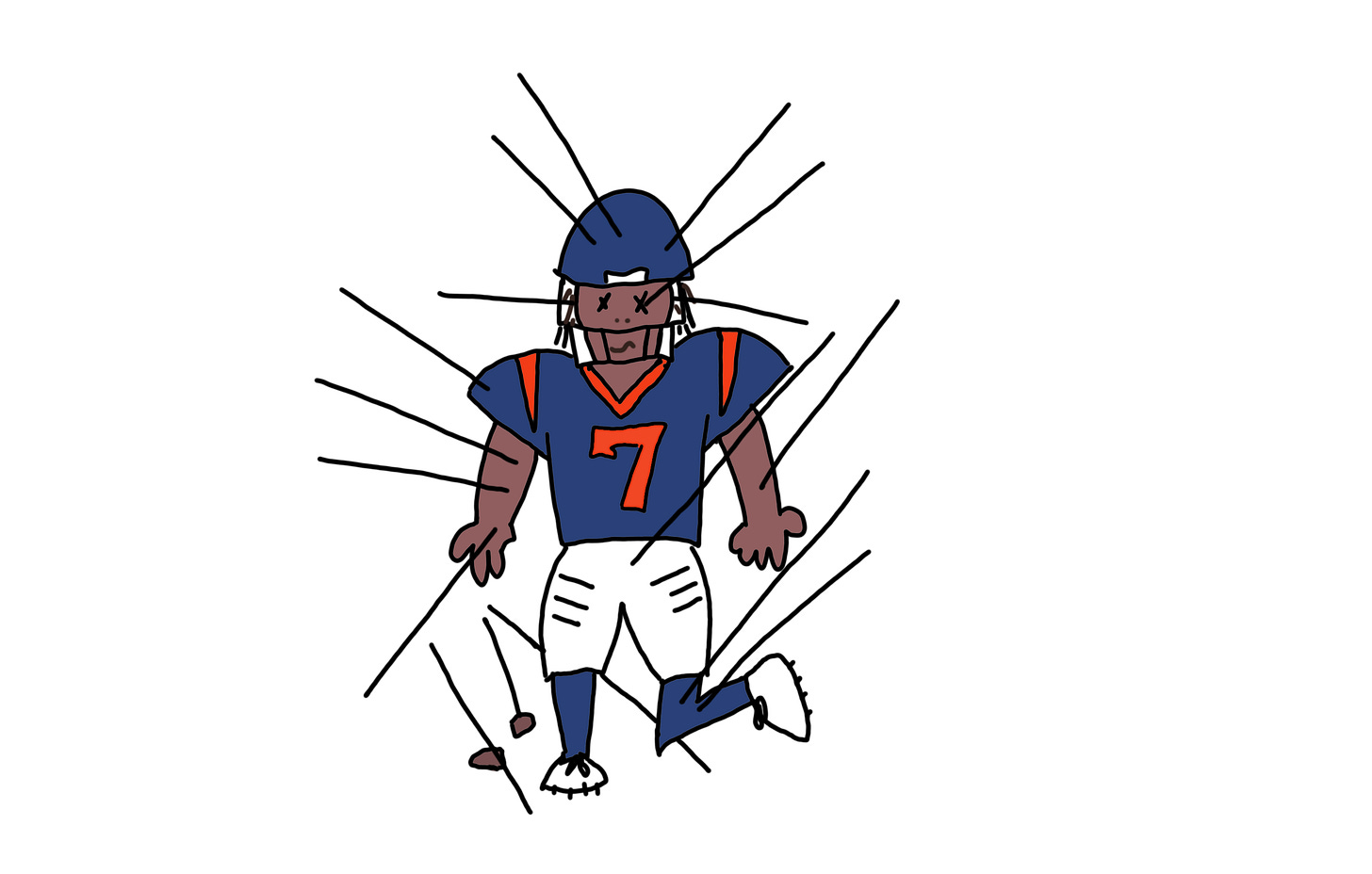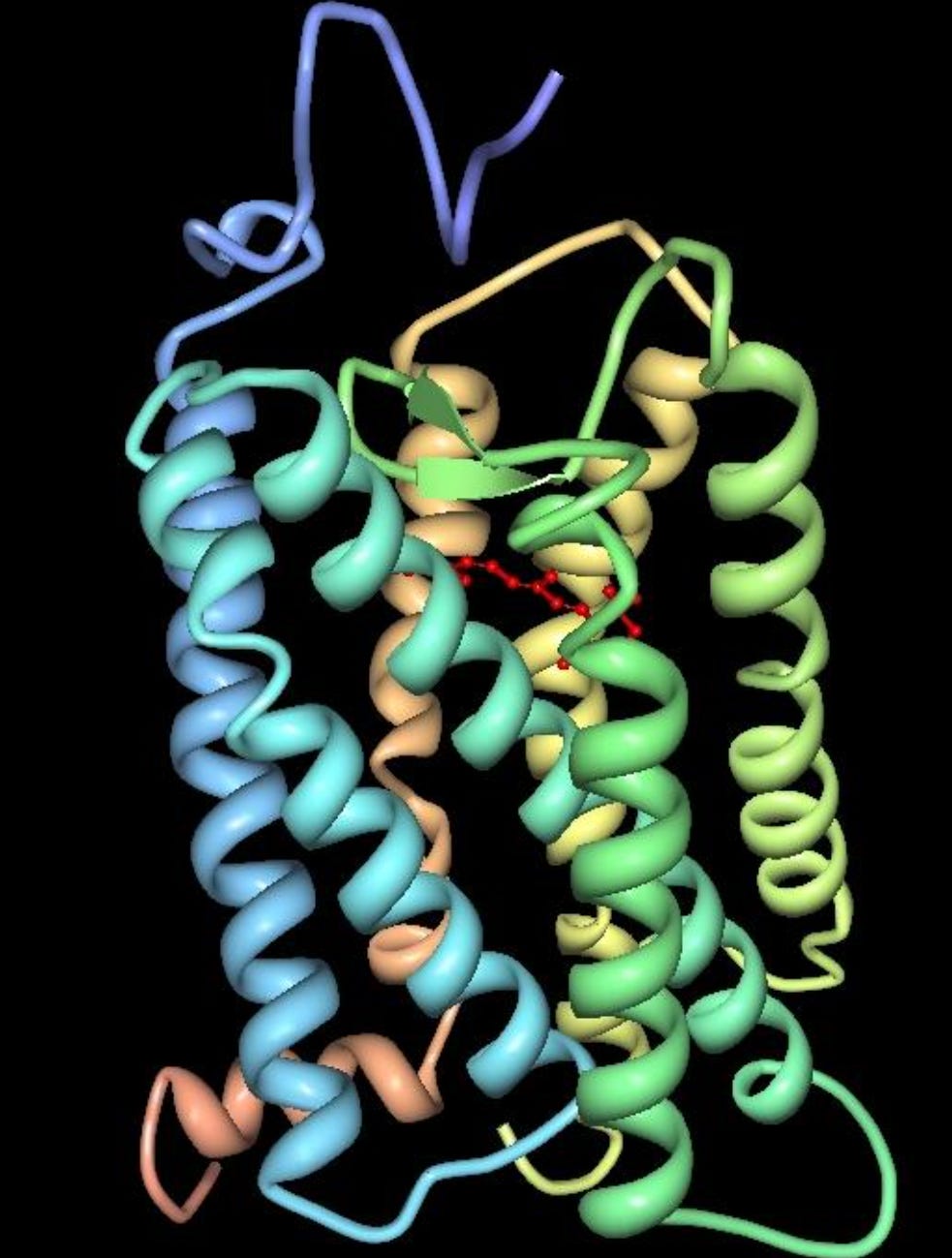CJ STROUD & S2 COGNITION: Voodoo dolls, blank slates, and playoff dates.
The NFL Superstar Tackling The World Of Cognitive Neuroscience
The universe possesses very few certainties, but let me give you three:
Nothing will nourish your soul like a warm plate of food.
There is no better place to watch a sporting event than Anfield, Liverpool.
Playing quarterback in the NFL is the hardest position in professional sports.
Neither of these is up for debate. I once had a summer employee perpetually insist that an MLB relief pitcher was the toughest position in sports.
Not even close. He attempted to bolster his claims with anecdotal data points about hormone profiles and random statistical analyses. I fired him before Canada Day.
2023 NFL DRAFT
I first heard of S2 Cognition in the lead up to the draft. A college football player I was rehabbing in clinic talked about a company called S2 becoming the “brain training” platform of choice for both the NCAA and the NFL.
“It can analyze how fast your eyes are, how quickly you make decisions, and how your brain is wired”.
He spoke with the exuberance you come to expect from any highly motivated athlete looking to take their game to the next level. But, I’ve also heard these trite proclamations multiple times before, so it didn’t really register.
When, a few days later, I received multiple articles about the company from a respected sports agent, I mustered up enough cognition to actually check out the website.
The site has your typical sporty science vibe with its dark background and game-winning neon headlines. There’s a decent mix of proverbial science chatter interspersed with pseudo-practical applications to your sport of choice.
S2 Cognition wasn’t the first, and definitely isn’t the last company in the expansive world of “athlete testing”, so I didn’t give it much thought or credence. That was until articles began surfacing linking a player’s performance on the test to his prospects in the upcoming draft.
___________________________________________________________________
APRIL 21, 2023: “QB: Bryce Young Has The S2 Advantage” - Sports writer Bob McGinn releases his 39th consecutive NFL Draft Series
Leaked information reveals that Ohio State star quarterback CJ Stroud scored an abysmal 18 out of 99 on his S2 Cognition test. NFL executives begin hitting the abort button on CJ Stroud due to an apparent lack of “football intelligence”.
On the flip side, Alabama QB Bryce Young scores an impressive 98/99. Owners and executives solidify him as the number one pick. Pre-draft votes for rookie of the year are pretty much a formality as S2 Cognition is widely considered, “A great test”.
APRIL 21, 2023: “We’ve Never Had Somebody Grade Low and Play Well.” - The S2 Cognition Test Could Tank CJ Stroud’s Draft Stock
An article from Barstool Sports sheds further light on CJ Stroud’s astonishingly poor performance on the test. Additional NFL owners and executives make further claims that his poor score of 18 hinders him leading into the draft.
___________________________________________________________________
In my mind, the situation bordered on insanity! CJ Stroud’s stock was dropping faster than the testosterone levels of a fortysomething year-old vegan dude.
I wondered how he would handle the growing kerfuffle. Would it place doubts in his mind? Was he scared of being relegated to the deeper rounds of the draft? Was he nervous about not being drafted at all, and having to work at Walmart for a living due to his intellectual incompetence? Or even worse, maybe he would end up in the CFL (no money + brain trauma = worse than Walmart). On the contrary, his response was brilliant:
“I’m not a test taker. I play football.”
He said with the poise and confidence of a player who fully understands his capabilities.
WHAT IS THE S2 COGNITON TEST?
From the company’s website,
“The S2 System combines state-of-the-art technology with an in-depth understanding of how athlete’s brains are wired for the game”.
You scroll through well-designed webpages and read about what it takes to be a high performing athlete,
“The exam lasts 30-45 minutes. It’s performed on a specially designed gaming laptop and response pad that can record reactions in two milliseconds. To put that in perspective, an eye blink lasts 100-150 milliseconds”. (more on this point later)
At first glance, it’s easy to see why numerous sports leagues, including the NFL, would be smitten. This is especially true when it comes to the unique, difficult-to-measure attributes of what makes a successful NFL quarterback.
BEYOND WONDERLIC
The marketing folks at S2 put the pedal to the medal leading up to the draft. The founders Brandon Ally and Scott Wylie were on podcasts, NFL talk shows and other outlets explaining how their evaluation tool was a “scientifically proven” way to measure an athlete’s ability. The narrative always led to the quarterback position, yet the company was understandably reluctant when it came to releasing player scores.
The NFL had long contemplated dumping their existing, much-maligned assessment tool which was the Wonderlic Test; a useless 12 minute, 50 question, SAT type test that had zero predictive performance capacity whatsoever. Case in point, the top three QB Wonderlic scores ever:
Greg McElroy- 48
Ryan Fitzpatrick- 48
Blaine Gabbert- 42
The new kid on the block seemed to fill an obvious void. Measuring a quarterbacks “perception speed” makes more intuitive sense than vowel positioning within the alphabet.
That was until information was leaked that first pic front runner CJ Stroud scored 18. S2 Cognition Founder Brandon Ally was quick to respond, telling reporters far and wide to take the report with “a grain of salt”. Something impossible to do considering all the hoopla surrounding the NFL’s new poster child.
One minute, this uber-specialized “brain wiring” technology provides the type of information that teams would die for, then in the next minute, it should be taken with a grain of salt?
So, what’s the deal? Is CJ Stroud’s poor performance just an outlier, or is it possible that the S2 Cognition test is not all it’s cracked up to be? But before we dig into specifics, I will do something that normally gets done towards the end of a research paper; declare any conflicts of interest. Admittedly I have many, and since this is not a research paper I will admit to a few biases as well.
CONFLICTS:
I spent 10 plus years administering computer tests to athletes across various platforms and technologies. 600 plus tests to date.
Paid consultant to athlete’s, teams, and organizations. Most of them are either not using S2 Cognition, use a competitor, or nothing at all.
Worked for a neuroimaging company (Performance Phenomics now called Voxel AI) where I oversaw taking ACTUAL BRAIN DATA from neuroscientists and turned it into actionable performance strategies for athletes.
Advisor to a company called Netramark that uses a kick-ass machine learning system to help pharmaceutical companies fail less often. Their system is often “learning” from data sources such as brain imaging, EEG data (electrical brain activity) and genetics.
BIASES:
Autobiographical Bias: I realize that my own experiences may be clouding my judgement.
Historical Bias: There is no doubt that 600 plus tests with little to no predictive performance value has altered my own neurons in a way that has made me permanently pessimistic.
Confirmation & Recency Bias: Let’s group these two together. I have worked with a small number of athletes and non-athletes using the S2 platform in the last two years. This has strengthened my previous biases and conflicts.
Knowledge Bias: The brain just don’t work that way!
HATE THE GAME NOT THE PLAYER
This is not a solo attack on S2 Cognition. I like what they are trying to do and imagine they whole heartedly believe in pushing cognitive testing forward in the world of sport. They have taken the widely held view of how the brain works, anchored in centuries of Eurocentric thought. This is fine when discussing research topics within the ivory tower of academia, or when giving poster presentations at self-indulgent cognitive neuroscience conferences (which I do love). Problem is, when it comes to the very real world of professional sport, it’s all wrong.
DECARTES ERROR
17th-century philosopher Rene Descartes made seminal contributions to many fields of study. He was highly influenced by early Greek thinkers like Plato and Aristotle. He spent much of his time ruminating on the musings of bald men with magnificent beards, and had a particular fascination with the concept of “mind”.
“What is mind? Where does it come from? Where does it go when we die? Do our animals have “mind”?
He was a reductionist at heart and deeply religious. Dualism was born and served as a congenial framework for this type of thinking. A metaphysical bifurcation with the mind and body seen as distinct entities, each with their own nature.
Over the next few centuries terms began to emerge that defined the individual characteristics of the mind. Attention, as a means of focus. Intention, to describe wants and desires. Cognition, to illustrate various forms of thought.
As new terms emerged over the centuries, they occupied more and more of the brains real-estate; goal seeking, memory, planning, creativity, desire, imagination, instinct, reason etc. In fact, in the human prefrontal cortex alone there is thought to be more than 100 behavioural terms associated with it.
BLANK SLATE
This level of reductionism has diminished the human brain down to a blank slate (tabula rasa), akin to a library with empty shelves and barren hallways upon birth. Experience then layered into the brain, forming everything we become, both consciously and subconsciously. A dualistic framework to experience the world, as well as react to it.
BRAIN OF AN NFL QUARTERBACK?
Whether intentional or not, S2 Cognition has adopted this reductionist framework when determining the skills necessary to be a successful NFL quarterback. The 30-45 minute test measures a players competence across nine categories:
Perception Speed
Search Efficiency
Tracking Capacity
Instinctive Learning
Visual Learning
Decision Complexity
Distraction Control
Impulse Control
Improvisation
The goal of the test is to measure how quickly, or not, an individual processes information across these categories. The results get scored out of 99. Their entire model is based on the premise that the better you score, the better your brain is wired, and therefore the better you will play.
When asked which of the characteristics were of the greatest importance to the success of an NFL quarterback, founder Brandon Ally said, “tracking multiple objects, decision complexity and improvisation”. Three neatly defined characteristics seemingly filed away into the neocortex of ambitious athletes everywhere, disconnected from their wasteful bodies.
BUST OUT THE VOODOO DOLLS
I can just imagine the emergency internal meeting that would have been called at S2 when CJ Stroud’s score 18 out of 99 was released to the media.
“Uh okay everybody, uh we seem to have an issue here. Looks like top prospect CJ Stroud has just shit the bed on his test. Does anyone know if he actually shit on the video game console? Did any of you programmer guys leave semen all over the joystick buttons? We have a real problem here”.
Then, I’d imagine to their own surprise, news began to emerge of executives within NFL organizations siding with the test score:
“Stroud scored 18, that is like red alert, red alert, you can’t take a guy like that. That is why I have Stroud as a bust”.
And the award for Worst Aging Quote of the Season, goes to another NFL exec who put it blatantly:
“That was my concern with him, his personality is just sort of calm and mellow and laidback, and that’s the way he plays. You look at how Bryce Young plays and how Stroud plays, I don’t see how anyone can look at those two play football and you’d want that guy Stroud over Young”.
TALE OF THE TAPE
2023 NFL REGULAR SEASON
CJ STROUD VS BRYCE YOUNG
TD’s= 23 TD’s= 11
INT’s= 5 INT’s= 10
YARDS= 4108 YARDS= 2877
PASSER RATING= 100.8 PASSER RATING= 73.7
If I were the boss at S2 I would have mandated every employee to go home and make the largest fucking voodoo doll of CJ Stroud imaginable, two weeks into the season. Each completed pass warranting a needle through his body, each touchdown a spike driven through his 18/99 brain.
But it wouldn’t have worked. Doll or no doll, Stroud was well on his way to breaking NFL rookie passing records and is a shoo-in for Offensive Rookie Of The Year. It’s not only that he played lights out in leading his team into the playoffs this weekend. It’s the confidence and composure he showed that was most impressive.
In full disclosure, it should be obvious that there’s no way of knowing with 100% certainty who will succeed in the upper echelons of professional sports. Plus, Ohio State quarterbacks have notoriously underperformed at the pro level, so you can’t hate on anyone for thinking that Stroud was gonna be a bust.
The thing that bothers me is the immense value placed on playing a video game. I’m all in on technology leading us forward in the world of pro sport and beyond, but the folks doing due diligence on these types of technologies needs to do a better job. If there is no due diligence being done, which I suspect is the case, that is an even bigger problem.
SEARS & NEUROSCIENCE
Remember Sears? Most neurotechnology companies behave just like Sears. They are designed to compartmentalize. Kids shoes, first floor to the left. Women’s coats, third floor next to the toilets. Outdated furniture? That’s tucked into an eerie, dimly- lit corner of the fifth floor.
S2 Cognition does the same thing. Decision making is frontal lobe behind the forehead. Is that diamond on the screen missing its left or right side? Thats decision complexity, down the hall to your left. And much like getting in and out of Sears as fast as possible, before the anguished fluorescent lightning has a chance to devour your soul, you rip through the nine departments of testing ASAP. All players neatly compartmentalized across criteria, producing a score that is supposedly suggestive of the athlete’s ability, or lack thereof.
The problem is, this does not reflect reality in the slightest and therefore has zero predictive value in terms of an athlete’s abilities.
Most cognitive neuroscientists want to usher our cognitive superpowers into the safe and sturdy confines inside our skulls, but this is a massive mistake.
“Biology has been solving complex problems long before brains ever existed”. Dr. Mike Levin
It may appear that our basic senses operate along a space/time continuum easily observable from our under-funded labs, and over- valued companies, but this is also a mistake.
An example of what I mean straight from S2’s website:
SEE. PROCESS. ACT.
Their entire technology is based on the ability to record reaction time down to the millisecond level. How quick an athlete can SEE, PROCESS, and ACT. The quicker and more accurate you are, the better your score. The human brain as nature’s Ultimate Processing Tool. Alabama QB Bryce Young as the Ultimate Processing Machine with his rapidly reacting eyes, and lightning quick thumbs.
But what if the human brain did NOT evolve to be a processing tool? That in fact it is quite the opposite; a self-organized, dynamic CONTROL tool that doesn’t give two shits about what it sees on a screen, football field, or anywhere else for that matter.
Back to the S2 website:
“The exam lasts 40-45 minutes. It’s performed on a specially designed gaming laptop and response pad that can record reactions in two milliseconds. To put that in perspective, an eye blink lasts 100-150 milliseconds”.
WOW! Seems pretty darn fast doesn’t it? The technology can measure reaction time 50+ times faster than the blink of an eye! How can this not be a great indicator of an athlete’s visual supremacy? His/her ability to process faster than a competitor surely gives them an edge does it not? No.
VISION AND THE BRAIN
The human brain has better shit to do (keep itself alive) than sit around waiting for you to play a video game. Your brain pre- emptively operates through space and time, oblivious to your wants and desires, at a speed that stretches the bounds of our reality.
RHODOPSIN
Rhodopsin is a protein pigment found in the rod photoreceptors of the retina (layer of cells at the back of the eyeball sensitive to light). Rhodopsin has the critically important role of converting photons of light into chemical signals, by changing shape to capture the energy emitted by the photons of light. These are the initial steps towards vision and they happen incredibly fast.
___________________________________________________________________
RHODOPSIN CONVERTS PHOTONS WITHIN APPROXIMATELY 200 FEMTOSECONDS
200 FEMTOSECONDS = 0.0000000000002 SECONDS
A femtosecond is one quadrillionth of a second. In other words, incredibly fucking fast!
S2 CAN MEASURE REACTION TIME IN TWO MILLISECONDS
2 MILLISECONDS = 0.002 SECONDS
The two time stamps are worlds apart from a speed perspective, and quite far from a distance perspective as well.
THE SPEED OF LIGHT TRAVELS AT 186 MILES PER MILLISECOND
2 MILLISECONDS = 372 MILES OF LIGHT TRAVEL
200 FEMTOSECONDS = 0.0024 INCHES OF LIGHT TRAVEL!!!
___________________________________________________________________
BRAINS ACT FIRST
These quicker than lightning femtosecond functions are happening way faster than what we can consciously perceive. If the brains of CJ or Bryce were processing tools waiting to react to the visual world, they wouldn’t be in the NFL. In fact, they wouldn’t even be alive. None of us would be.
The brain acts first. The brain is in control because that it is how it developed through hundreds of millions of years of evolution. It cares about staying alive and nothing else. Acting first is what enables it to do so. If our pre hominin ancestors relied solely on our conscious rudimentary senses for survival, we wouldn’t be here.
This doesn’t mean there’s anything inherently wrong with measuring our conscious reaction time down to a couple milliseconds. But what it says about an athlete’s ability or potential is pretty much nothing.
You gotta ask yourself,
“Should I be Wazing the traffic patterns of Pittsburgh, Pennsylvania if I’m driving 370 miles away in downtown Manhattan”?
I would hope not. And I know it sounds like I’m shitting on the S2 system, but I’m not (okay maybe a little). But when they’re telling folks that measuring reaction time down to the two millisecond level is indicative of an athlete’s capabilities, it simply isn’t true.
MAKING TECH
No technology is ever going to be perfect. When developing athlete-focused technologies (or any for that matter), it is crucial to understand that the technology itself can only be as good as those observing it, as well as the tools used to observe.
That is why we must approach the assessment of an athlete’s quality carefully and with humility.
Anytime an athlete gets measured outside of sport with a set of reductionist tools, we should pause.
Anytime we ask athletes to sit at a desk, in a scanner, or play a video game which disengages their body from their brain, we should pause.
Anytime an athlete gains a “training effect” advantage by doing the test a number of times more than the competition (Bryce did the test numerous times more than CJ), we should pause.
Anytime we talk about “brain wiring” without looking at an actual brain, we should pause.
Anytime we decide to ignore that much of what happens in the brain is under the control of ancient, hard-wired autopilots in the brain and spinal cord, we should pause. I could continue, but you get the point.
MAKING MAGIC
We need better technologies and tools moving forward (future article). We need to appreciate and embrace the interlocking reciprocity between the brain and body, not ignore it. This is especially true in great athletes.
Our ability to observe through time will lead to our improved ability to analyze. Our deepening analysis will lead to our ability to synthesize. To aid in the development of athlete’s who possess a special type of magic not quantifiable to us at this moment in time. A fourth universal truth.
In the meantime, let’s enjoy CJ Stroud’s poise, confidence, and flat-out ability to ball like no other. He himself, said it best prior to the draft:
“At the end of the day if you don’t trust and believe me, watch this”!






